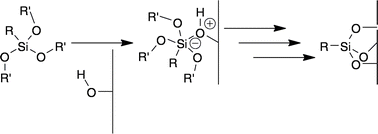Functionalization of glass substrates: mechanistic insights into the surface reaction of trialkoxysilanes†
Abstract
Modification of substrates by trialkoxysilane reagents is the most common method employed for surface functionalization. Classically, the mechanism for surface reactivity in trialkoxysilanes is described as proceeding through a trisilanol intermediate. Here, we present data that contradict this mechanism and propose an alternative mechanism, in which trialkoxysilanes react directly with surface hydroxyl groupsvia an addition–elimination type mechanism.


 Please wait while we load your content...
Please wait while we load your content...